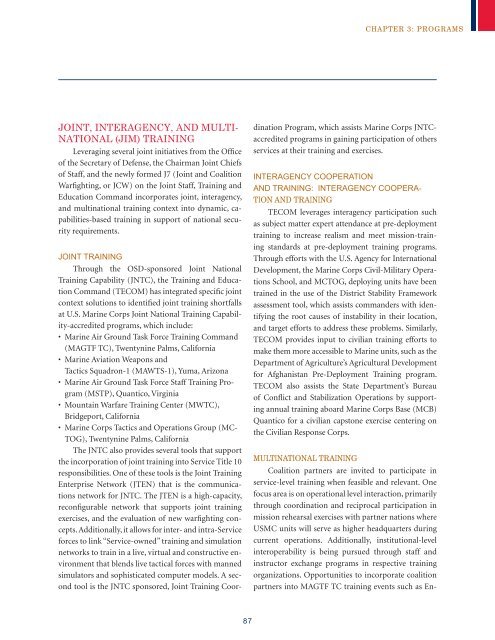USMC Concepts & Programs 2013 - Defense Innovation Marketplace
USMC Concepts & Programs 2013 - Defense Innovation Marketplace
USMC Concepts & Programs 2013 - Defense Innovation Marketplace
Create successful ePaper yourself
Turn your PDF publications into a flip-book with our unique Google optimized e-Paper software.
chapter 3: programs<br />
JOINT, INTERAGENCY, AND MULTI-<br />
NATIONAL (JIM) TRAINING<br />
Leveraging several joint initiatives from the Office<br />
of the Secretary of <strong>Defense</strong>, the Chairman Joint Chiefs<br />
of Staff, and the newly formed J7 (Joint and Coalition<br />
Warfighting, or JCW) on the Joint Staff, Training and<br />
Education Command incorporates joint, interagency,<br />
and multinational training context into dynamic, capabilities-based<br />
training in support of national security<br />
requirements.<br />
Joint Training<br />
Through the OSD-sponsored Joint National<br />
Training Capability (JNTC), the Training and Education<br />
Command (TECOM) has integrated specific joint<br />
context solutions to identified joint training shortfalls<br />
at U.S. Marine Corps Joint National Training Capability-accredited<br />
programs, which include:<br />
• Marine Air Ground Task Force Training Command<br />
(MAGTF TC), Twentynine Palms, California<br />
• Marine Aviation Weapons and<br />
Tactics Squadron-1 (MAWTS-1), Yuma, Arizona<br />
• Marine Air Ground Task Force Staff Training Program<br />
(MSTP), Quantico, Virginia<br />
• Mountain Warfare Training Center (MWTC),<br />
Bridgeport, California<br />
• Marine Corps Tactics and Operations Group (MC-<br />
TOG), Twentynine Palms, California<br />
The JNTC also provides several tools that support<br />
the incorporation of joint training into Service Title 10<br />
responsibilities. One of these tools is the Joint Training<br />
Enterprise Network (JTEN) that is the communications<br />
network for JNTC. The JTEN is a high-capacity,<br />
reconfigurable network that supports joint training<br />
exercises, and the evaluation of new warfighting concepts.<br />
Additionally, it allows for inter- and intra-Service<br />
forces to link “Service-owned” training and simulation<br />
networks to train in a live, virtual and constructive environment<br />
that blends live tactical forces with manned<br />
simulators and sophisticated computer models. A second<br />
tool is the JNTC sponsored, Joint Training Coordination<br />
Program, which assists Marine Corps JNTCaccredited<br />
programs in gaining participation of others<br />
services at their training and exercises.<br />
Interagency Cooperation<br />
and Training: Interagency Cooperation<br />
and Training<br />
TECOM leverages interagency participation such<br />
as subject matter expert attendance at pre-deployment<br />
training to increase realism and meet mission-training<br />
standards at pre-deployment training programs.<br />
Through efforts with the U.S. Agency for International<br />
Development, the Marine Corps Civil-Military Operations<br />
School, and MCTOG, deploying units have been<br />
trained in the use of the District Stability Framework<br />
assessment tool, which assists commanders with identifying<br />
the root causes of instability in their location,<br />
and target efforts to address these problems. Similarly,<br />
TECOM provides input to civilian training efforts to<br />
make them more accessible to Marine units, such as the<br />
Department of Agriculture’s Agricultural Development<br />
for Afghanistan Pre-Deployment Training program.<br />
TECOM also assists the State Department’s Bureau<br />
of Conflict and Stabilization Operations by supporting<br />
annual training aboard Marine Corps Base (MCB)<br />
Quantico for a civilian capstone exercise centering on<br />
the Civilian Response Corps.<br />
Multinational Training<br />
Coalition partners are invited to participate in<br />
service-level training when feasible and relevant. One<br />
focus area is on operational level interaction, primarily<br />
through coordination and reciprocal participation in<br />
mission rehearsal exercises with partner nations where<br />
<strong>USMC</strong> units will serve as higher headquarters during<br />
current operations. Additionally, institutional-level<br />
interoperability is being pursued through staff and<br />
instructor exchange programs in respective training<br />
organizations. Opportunities to incorporate coalition<br />
partners into MAGTF TC training events such as En-<br />
87

















